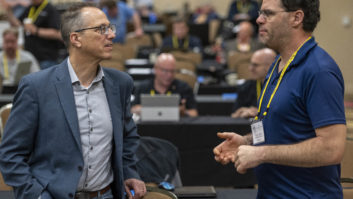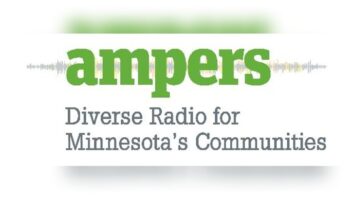The word unique is overused but seems appropriate when applied to KSUT Public Media.
Licensed to Ignacio, Colo., in a region of the southwest known as Four Corners, KSUT is a National Public Radio affiliate but also has long been known for its live and local programs and its commitment to community service.
KSUT was founded in 1976 by the Southern Ute Indian tribe with a goal of keeping tribal members informed and entertained. Today, KSUT provides two services.

One, “Tribal Radio” (KSUT), serves as the voice of the Native Americans who live in the area. It plays traditional Indian music, provides news and talk shows about issues of concern to the community, and tells the stories the mainstream media often ignore.
The other, “Four Corners Public Radio” (KUTE), offers a blend of popular NPR staples like “Morning Edition” and “All Things Considered,” as well as a locally-programmed adult album alternative (Triple A) format. The station’s playlist includes not only big names like Joni Mitchell or Coldplay but also local artists, in-studio live concerts, jazz, blues and world music.
REFLECTION OF THE REGION
While a lot has changed in the more than four decades since KSUT made its debut, the community focus has never wavered, according to Executive Director Tami Graham.
“We reflect the cultural diversity of the region. We’re unique because we’re tribally-founded, and we stay true to our roots; but we are also an NPR affiliate and an independent nonprofit.”
Graham is proud of KSUT’s success and its popularity in the region. In fact, it was recently voted “Best Radio Station in Durango and La Plata County” for the sixth consecutive year, in a reader poll by the Durango Herald.
Graham oversees an 11-person staff, and she wears many hats, as do her colleagues. Graham’s include fundraising and grant-writing (an ongoing part of being a listener-supported station); and she hosts an on-air shift on Four Corners Radio on Wednesday afternoons.

Four Corners Station Manager Rob Rawls also handles day-to-day engineering and hosts a Tuesday night blues show. Four Corners Music Director Stasia Lanier, who has been with KSUT for 25 years, not only oversees the station’s music but helps with marketing and promotion, and can be heard Tuesday afternoons on “Afternoon Blend” as well as on a Saturday morning program called “San Juan Sunrise.”
When KSUT went on the air in June 1976, it was one of the few tribal radio stations in the United States; back then, it had only 10 watts and a signal that could be heard for about 20 miles, and it broadcast four hours a day.

And yet, as Lillian Seibel, KSUT’s first station manager, recalls: “People appreciated [KSUT] right from the beginning. It was exciting for them to hear native music.”

Today, says Tribal Radio Station Manager Sheila Nanaeto, native music is key to the station’s identity; she hosts the morning show, and she enjoys promoting the songs of native artists. And while the station’s founders were Southern Utes, the music comes from all tribal groups.
But the station is known for more than just the music. It is also a focal point for educational programs on health, the environment and other issues. There are nationally produced talk shows like “Native America Calling,” but there are also locally produced programs.
For example, Nanaeto says, “We reached out to different organizations, who came in to discuss how they were preventing domestic violence.” Included in the 42 hours a week of native-oriented programming, Nanaeto hosts a show aimed at the homebound elderly population. And because Tribal Radio broadcasts high school sports as well as reporting live from area pow-wows. “People know us … and we have listeners of all different ages.”
KSUT’s two signals serve 14 towns across parts of four states (Colorado, Utah, Arizona and New Mexico). It’s quite a challenge serving such a wide area. Twice a day, the organization’s footprint results in a very long station ID, reflecting the call letters of six FM transmitters and four FM translators. The market is unrated, but by many accounts, KSUT reaches a potential audience of more than 200,000 people. (Most of the time, the stations just use the KSUT identifier, and the website’s audio stream, too, refers mainly to KSUT.)
Rob Rawls explains the logistics: “Tribal Radio [KSUT]’s main transmitter is 2,000 watts and is located in southwest Colorado. The Tribal signal is repeated in New Mexico on KUUT at 500 watts. Four Corners’ primary transmitter is located in southwest Colorado and runs at 900 watts. Four Corners is re-broadcast on KDNG in Durango [200 watts], KUSW in Farmington [900 watts] and KPGS in Pagosa Springs [500 watts].”
Both services also can be heard via the KSUT.org website.
THE GOODS AND THE GEAR
He also mentioned the technology behind the on-air product: “KSUT uses a mix of Harris, BE and Crown transmitters and translators. Most of KSUT’s transmitter sites now have internet, which allows KSUT to use Comrex Bric Links to deliver our programming to remote locations. KSUT is an NPR affiliate, receiving national programming through a 4-meter satellite dish … KSUT manages music, national programming and local programming using NexGen automation from RCS Sound Software.”
He also notes that KSUT is in the process of building a new broadcast facility, which everyone hopes will result in an upgrade of the current equipment.
“And boy, do we need it,” Rawls says. “KSUT on-air studios currently use 20-year old analog PR&E consoles that are in need of constant repair. KSUT has Tascam CD players in each studio, but they are rarely used. [There is] a digitized library of over 70,000 songs stored in a NexGen audio server — with a Raid 5 hard disk array — that is used by announcers, producers and programmers to create music programming. KSUT has standardized on EV RE-27 microphones for all studios. And audio processing is provided by an Orban Optimod 8600.”
Until 1998, KSUT tried to do it all with one service, but although the NPR programming was well-received (the station became an affiliate in 1984), some listeners felt the station was straying from its tribal roots. So, in June 1998, KSUT put the second on the air: Tribal Radio could now focus on the three Indian reservations within the signal range, while Four Corners could focus on the diverse blend of area residents that included students from Fort Lewis College in Durango, as well as tourists, and local residents drawn to the region’s scenic beauty.
As a listener-supported station, KSUT relies on fundraising drives in order to raise the money needed to operate. Fortunately, both Four Corners and Tribal Radio have loyal and devoted audiences: In the most recent fundraising campaign, more than $4.6 million was raised from area residents and businesses, as well as from grants (the Southern Ute tribe provided $1 million), augmented by some revenue that came from the Corporation for Public Broadcasting.
But raising money is an ongoing challenge, says KSUT’s Graham. She praises the Southern Ute tribe and tribal council for its commitment to KSUT’s success, and she is grateful for the many listeners who donate and who reach out to the station on social media.
EXPANSION AND OUTREACH PLANS
On Graham’s to-do list is getting funding for a tribal media center.
“Young people do care about radio,” she says, and she hopes to use the media center to train them to participate in broadcasting.
Graham also hopes to reenergize the station’s local news. Currently, due to budget cutbacks, there is no longer a local news department, but the plan is to restore local news coverage in the future. For now, the station uses its website for local headlines from area newspapers, and it broadcasts bulletins (such as impending bad weather) when they are received.
And like everyone on the staff, Graham is a big believer in the power of radio. “I fell in love with radio in college,” she explains, and after a long career in broadcasting, she ultimately joined KSUT because “I loved what the station was doing.”
People who think radio no longer matters haven’t listened to stations like KSUT, says Stasia Lanier. “KSUT is beloved in the region. Our slogan used to be ‘We create community on the air.’ People still think of us as a community asset.”
Donna Halper, Ph.D., is an associate professor of communication and media studies at Lesley University. The organization Historic New England recently awarded her its Prize for Collecting Works on Paper for her collection of memorabilia related to the history of broadcasting and pioneering men and women in the early days of radio and television.










